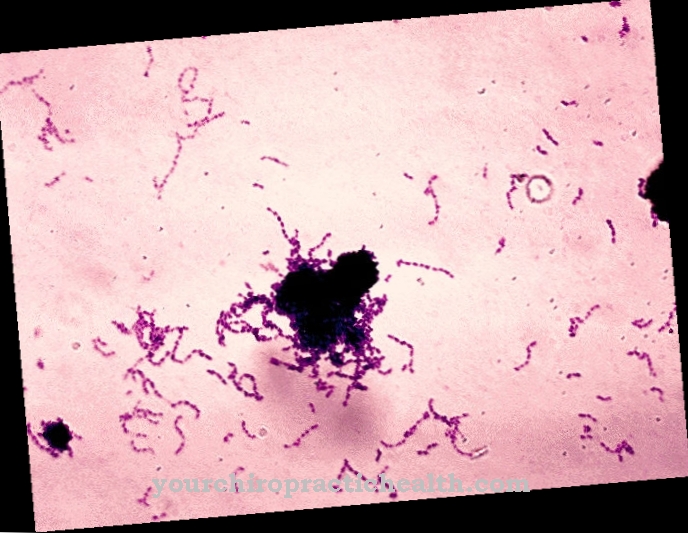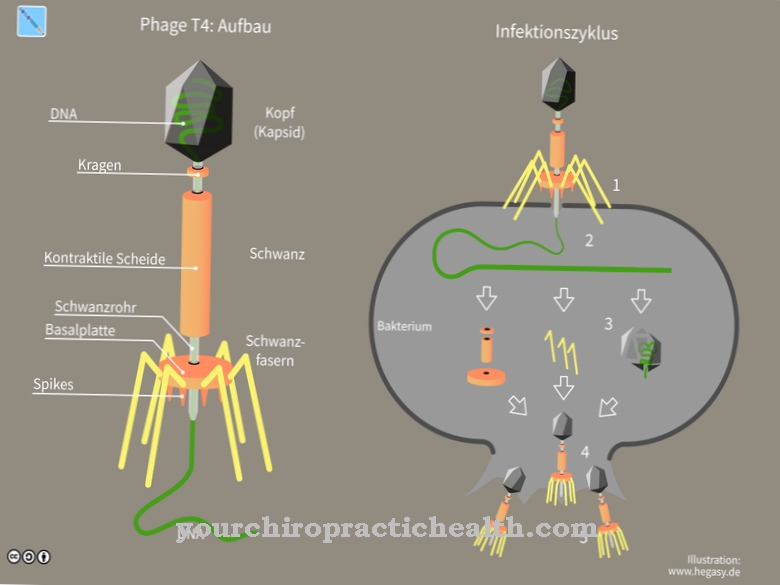Eating infected beef that has not been heated sufficiently can lead to infection with the Beef tapeworm (Taenia saginata) to lead. It is a parasitosis with a benign course. In Central Europe, the disease has become rare due to effective drugs.
What is the beef tapeworm?

The beef tapeworm belongs to the family of the so-called flatworms and, like all pathological parasites, goes through a certain development cycle, i.e. it requires an intermediate host as well as an end host for complete development and maturation. The intermediate host of the beef tapeworm is the cattle, the final host is the human. Although the infectious disease is rare in Germany, it is still the most common tapeworm disease in humans. The beef tapeworm consists of a head and many tapeworm limbs, the so-called proglottids.
When the tapeworm reaches a certain size, these segments are rejected via the anus. However, the head of the parasite has bored into the fine mucous membrane layers of the intestinal wall, from where it also takes the nutrients for its further growth.
Since the beef tapeworm is a hermaphrodite, fertilization takes place independently. After self-fertilization, the proglottids contain tapeworm eggs, which are excreted in the stool. A new tapeworm can only mature if its eggs are ingested by the intermediate host, in this case a cattle.
Occurrence, Distribution & Properties
The beef fin tapeworm lives and reproduces in the human intestine as a final host. With a new infection, the worm is only a few millimeters in size and barely visible. However, adult beef tapeworms can reach a length of up to several meters.
The infection rate has fallen sharply, especially in Germany, due to the state meat inspection. Because the encapsulated Finns can be seen quite well in the raw beef. Infection with the beef fin tapeworm is still a mass affliction in East Africa today. Even if the parasite can reach a considerable length, its presence often remains asymptomatic, meaning that the infected patients do not necessarily experience symptoms. The most striking symptoms of the disease is the discovery of tapeworm segments, proglottids, on the stool. Every proglottid has the ability to move on its own, so it can independently contract and move through muscular contraction.
The head of the beef fin tapeworm can be seen quite well under the light microscope. The most reliable diagnostic feature are the four suction cups with which the parasite attaches itself to the inner wall of the intestinal mucosa. There is no vital danger because the tapeworm is not able to penetrate the intestinal mucosa, which would result in a life-threatening condition.
In direct comparison with other human-pathogenic tapeworms, the beef tapeworm also remains in the intestine for life and does not spread to other organs. For the worm to develop fully, the eggs must be ingested by the cattle as an intermediate host. This happens because the human feces get into the wild as untreated sewage. Tapeworm eggs are very robust and can withstand adverse environmental conditions unscathed. The chain of infection is complete when the infected feces are spread on pastures and fields as fertilizer and consumed by grazing cattle.
It is known that rain washes tapeworm eggs from the contaminated soil and transfers them to neighboring pastures. As soon as the beef has ingested the eggs, they enter the ruminant's intestines undamaged. Once there, the larvae of the bovine tapeworm hatch from the eggs after several days. However, these eggs are able to pierce the intestinal wall and use the bloodstream to spread throughout the body. The target organ of tapeworm eggs in cattle is the well-perfused muscles, where they attach themselves and encapsulate in the form of a so-called fin. Humans, as final hosts, can then become infected with this meat. From the finned meat, the parasite grows into a sexually mature form in the human intestine. The development cycle of the beef fin tapeworm is then considered to be closed.
Illnesses & ailments
Symptoms associated with beef tapeworm infection are rare. The main symptom in an advanced stage of infection with Taenia saginata is weight loss, because a full-grown beef tapeworm consumes enormous amounts of nutrients. In addition, you may experience general weakness, indigestion, loss of appetite, or nausea.
Causal therapy can be used at any stage of the disease. The single administration of a high-dose anthelmintic already ensures that the tapeworm including the head will die off safely. If the course is severe, appendicitis or intestinal obstruction can also occur, but these clinical pictures are the absolute exception in connection with the infection. Due to the unspecific or non-existent symptoms, the diagnosis can only be made using a stool sample.
An infection with the beef tapeworm can be effectively prevented by avoiding the consumption of raw or insufficiently heated beef. In Germany, the greatest risk of infection comes from so-called scrap meat or tartare. If beef is heated to over 70 ° C for just a few minutes, the fins of the tapeworm reliably die. There is then no longer any risk of infection. Freezing the meat at -18 ° C for a period of ten days also has the same effect.




























